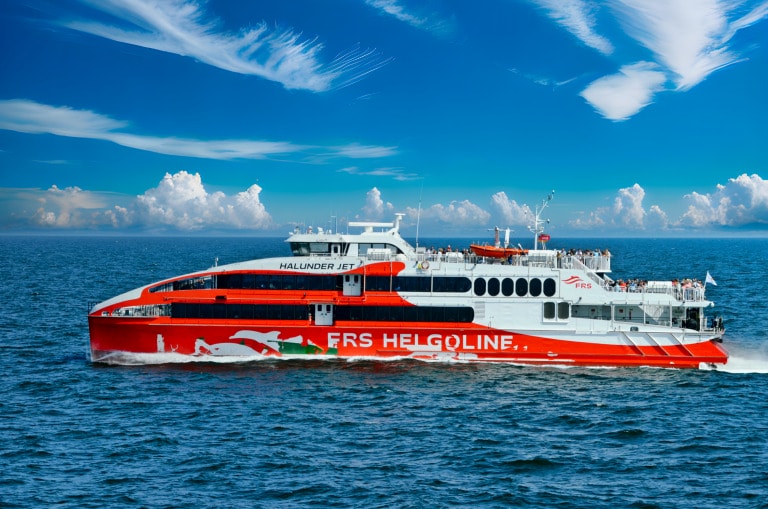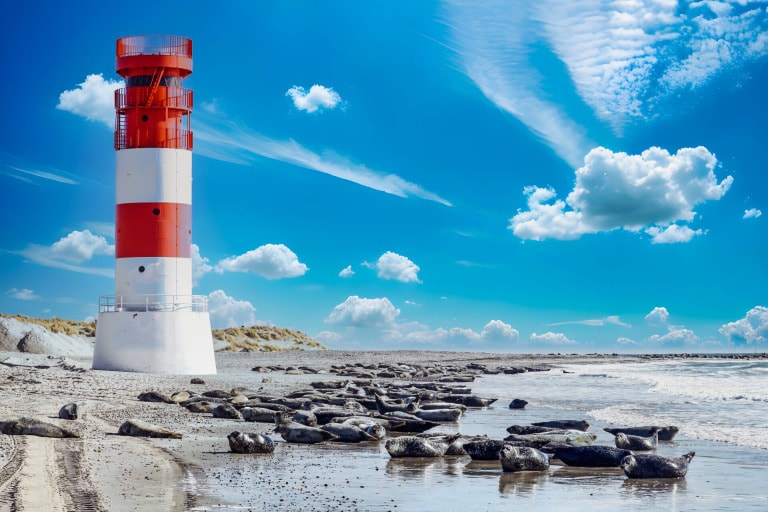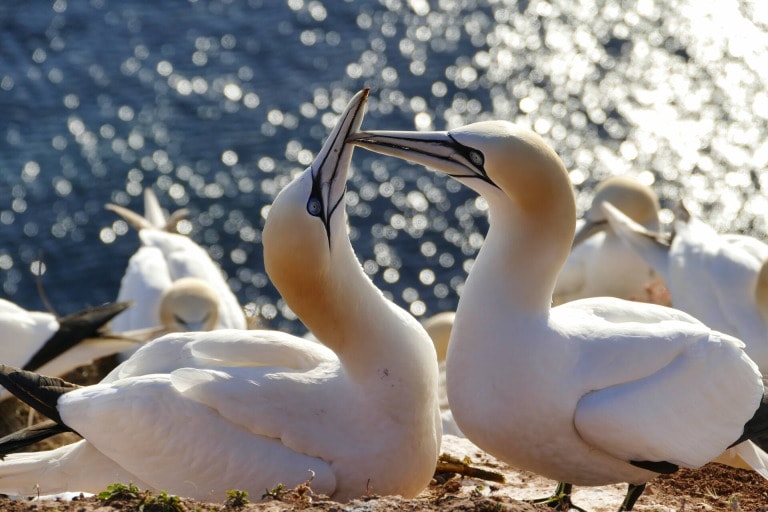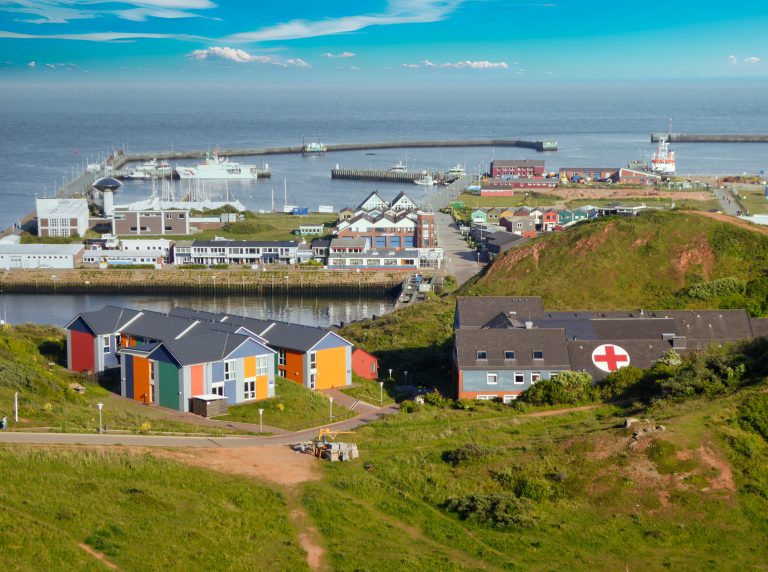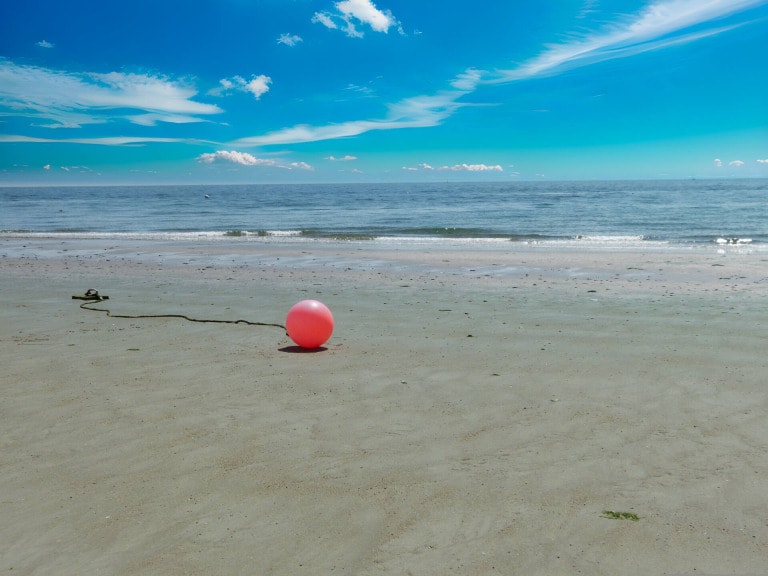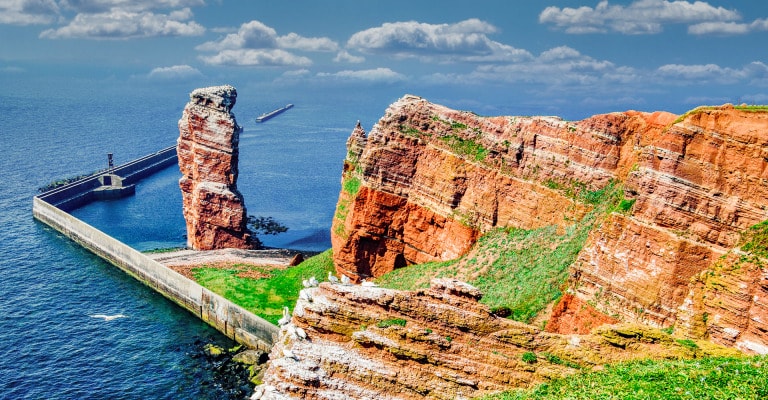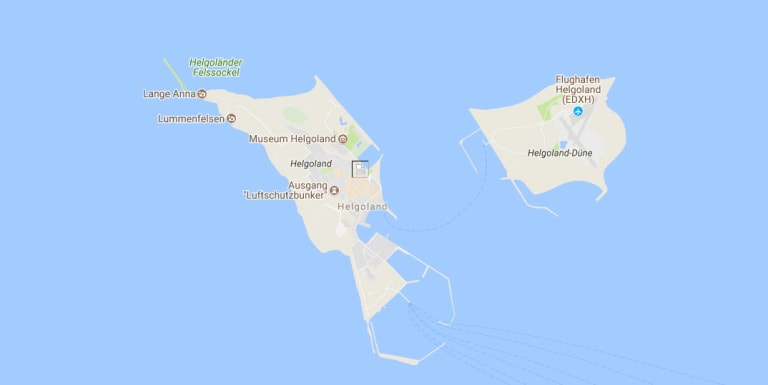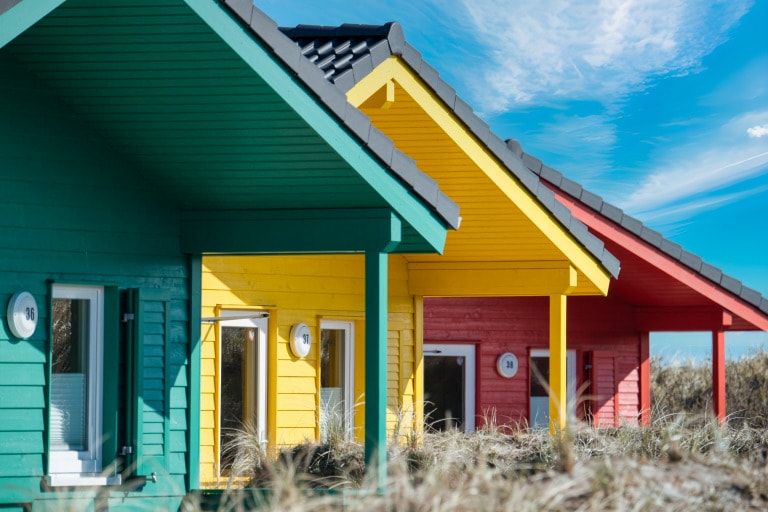Trustingly hoping that it would pass quickly and not leave behind too much destruction. But it was not only the storms that the Heligoland in the course of the centuries. He also had to come to terms with the constantly changing political balance of power.
Early history - 14th century
Long before the year 800, the "Heiligland" with the North Frisian mainland at the Eider as well as the Islands Föhr, Amrum and Sylt have been connected. Excavations point to grave finds dating back to 4000 B.C. In that period the first settlements took place. The chronicles tell of storm winds and water floods that swept away the land and reduced it in size. Of the original holy land, which is said to have been over three miles in size, only the red rock remained.
The first Frisians lived as farmers, fishermen and seafarers on the offshore Islands. They remained pagans until they were forced to convert to Christianity under the reign of Charlemagne.
Only the strongest survived and faced the battle with the sea. They learned to dike in order to expand their land. Fish, crabs, mussels and seabirds provided them with food, and in driftwood they found building materials and firewood. Again and again, storm surges, such as the Marcellus tide or the Great Man Trough, destroyed the land areas and with them the people. Their huts for storing tools and fishing gear, supplies and material as well as their animals were washed off the cliffs, their boats destroyed.
At that time no sovereign was interested in the island. Heligoland was subject to the Danish crown in the 13th/14th century and remained largely unmolested. There was nothing of value here and military bases were not yet needed at the time.
Only the pirate Claus Störtebeker shall be on Heligoland with his Vitalien brothers found a loophole in the rock, in which he hid the robbed gold and precious stones. Until he was picked up by the admiral's ship "Bunte Kuh" in 1401 and lost his head in Hamburg. So much for the legend. The "Bunte Kuh" still exists today: In the cozy restaurant in the Unterland you can dine and think of the buccaneer time.
1425-1714: Heligoland in the possession of Schleswig-Holstein-Gottorf
The life of the people of Helgoland changed abruptly when masses of herring shoals appeared off the island in 1425. This blessing benefited the Duke of Schleswig-Holstein-Gottorf, to whom the island fell in 1490.
Now Helgoland was no longer just any little island in the middle of the sea, but a rich source of income. Residents of the coastal towns participated in the catch and moved to the island. The herring blessing lasted for almost 100 years and gave the people of Helgoland a golden age. But by the middle of the 16th century the herring had disappeared and with it all the foreigners.
When the herring disappeared in the middle of the 16th century, all the immigrants also left the island.
After the absence of the herring shoals, Helgoland did not regain its momentum until after the end of the Thirty Years' War in 1648. Trade and the economy had to be revived. The shipping routes were used more intensively and the people of Helgoland were given the opportunity to prove themselves as pilots on the difficult Elbe and Weser fairways.
As captains and helmsmen, they traveled the world on merchant ships, participated in whaling and went to the North Sea to seal. They began to catch lobsters and export them to England and Hamburg. East of the dune was a productive oyster bank. They had found a new livelihood.
The lower land passed into a flat sand and scree beach to the dune, on which at that time rose limestone rocks as high as the red rock. Lime and gypsum had been mined from the "Witte Klyppe" since 1463, so that the remains collapsed anno 1711 after a storm tide. Only the "Woal" remained, which finally broke on New Year's Eve 1720/21 due to a strong storm. - Dune and island, as we know them today, were created.
1714-1807: Heligoland belongs to Denmark
Duke Frederick of Schleswig-Gottorf was in alliance with the great power Sweden. Together they had allied themselves against Denmark, which together with Poland and Russia was fighting for supremacy in the Baltic Sea region. When the Swedish army had to capitulate in 1713, the duke lost not only his ally but also Helgoland.
In August 1714, the Danish fleet anchored behind the dune and demanded the surrender of the island. After that did not happen, the Danes started shelling the land from fire mortars. When everything was burning and most of the houses had collapsed, the commander announced the surrender and offered the island for surrender. Until 1807 Helgoland was under the rule of the King of Denmark and his new capacity as Duke of Schleswig.
During the Danish period, the simple fishing settlement of Helgoland became a small town. A primitive fishing settlement became a small town. Ships arrived in increasing numbers in the harbor and promoted trade.
Denmark pursued a wise policy of neutrality and, supported by its significant navy, traded undisturbed with overseas and its colonies in the West Indies.
As in earlier times, the pilots of Helgoland took up their work to guide ships through the fairway. In 1787, they were granted the privilege as pilots around their island, which soon extended to a monopoly in the entire German Bight. By the end of the 18th century, there were 380 certified pilots on the island.
The widespread whaling at that time provided the Helgolanders with a well-functioning source of money. Fishing was expanded, especially haddock was fished with longlines. Around 1790 the "tiner" appeared, in which lobsters were caught with bait. The lobster shacks, where fishing equipment and tools were stored at that time, can be found today as reconstructions along the south beach.
The people of Helgoland brought it to a modest prosperity. The Danes married on Helgoland. In 1733, schooling was compulsory for children aged 6-14 for the first time. The number of inhabitants rose to 2,000 in 1751.
For insights into life at that time, the Helgoland Museum in the Nordseehalle is recommended.
1807-1890: Heligoland in possession of England
In 1802, the Elbe and Weser rivers were suddenly blocked by the English, so that all ships had to be rerouted. After decades of peace, this was the first alarm signal for those who belonged to the Kingdom of Denmark, including Helgoland.
England had considerably expanded its colonial empire. Napoleon Bonaparte had conquered all of mainland Europe except Russia. In order to subjugate the naval power of Great Britain as well, he imposed a Continental Blockade against the British Isles. This prohibited trade with the English.
Since the French naval forces had already been crushed, Napoleon needed a defensible fleet to take on England. Neutral Denmark possessed the only navy of note. In August 1807, an English squadron forced the surrender of the Danish warships lying in the harbor in order to remove them from Napoleon's grasp. But the Danes refused.
In September 1807, the island was finally surrounded by a huge English force. Heligoland surrendered and asked for a truce. The English marched on the Oberland, tore down the Danish flag and raised theirs.
In the winter of 1807/08, all food was scarce and costly, plus there was a bitter frost. The continental ban imposed by Napoleon on all English goods was disastrous for the inhabitants. Pilotage came to a standstill, and the mainland markets were closed to Helgoland fish and lobster. The people of Helgoland were in a bad way, they were starving and had no means of earning a living.
1807-1813 Smuggling trips
The British, however, discovered how to use Heligoland to get around the Continental Blockade. A smuggling trade in English colonial goods began. Although this was high risk, profits were soon made. Merchants from England, Holland and Germany joined in. The goods were unloaded on Heligoland and secretly transported via Wangerooge and Neuwerk to the mainland.
During this period, a stock exchange house was built. The people of Helgoland rented out living and storage space. Huge quantities of coffee, sugar, spices, cotton, earthenware and fabrics were stored in the Unterland. The inhabitants earned money by unloading and loading the ships and stacking the goods. Many Helgolanders participated in smuggling themselves. They became wealthy.
However, the short economic miracle disappeared as quickly as it had come. After the collapse of French rule on the mainland in 1813, orderly economic conditions returned. The Helgoland transhipment center was no longer needed.
On 14.01.1814 all former possessions were returned to Denmark, with the exception of Helgoland. The island was awarded to England.
This was a shock for the people of Helgoland. They could not return to their former occupations as fishermen and pilots because the few ships available were in poor condition. Their monopoly position in pilotage was gone. There had long been pilotage companies in the coastal towns for Elbe and Weser shipping. In addition, the Helgolanders were now English and as such could not sell their goods on German and Danish coasts. Even the Bürlottsystem, which had been guaranteed to the Helgolanders for centuries and according to which they were entitled to a share of the flotsam and jetsam in the event of ship salvage, went to the benefit of the state treasury.
While normal conditions returned in Europe, hunger and despair reigned on the island. England did not care about its new crown colony.
1826 Foundation of the seaside resort Helgoland
In the summer of 1824, a violent epidemic of rest suddenly occurred. This necessitated a doctor who settled permanently on the island. Once this was found, it was not long before the first pharmacy opened. Medical care was to contribute significantly to the establishment of the Helgoland seaside resort. The idea came from the shipwright Jacob Andresen Siemens.
Helgolanders, however, watched the emergence of the seaside resort with suspicion and pitying smiles. No islanders could imagine voluntarily going into the cold water and even paying money for it. Who wanted to sail across the island in a storm and rain with a sailboat? the North Sea ride? And what should be offered to bathers?
Nevertheless, the seaside resort of Helgoland opened on 01.07.1826. The shareholders of the seaside resort provided quarters. A casino was built as well as a reading room. At that time, this was one of the conditions that a seaside resort had to fulfill. The old stock exchange was prepared for spa guests. Here they could stay and eat. Two bathing carts were specially made.
All the beginning was difficult, in the first three years only about 100 guests arrived. But slowly the number increased, in 1830 they already counted 335 guests.
The hardship of the people of Helgoland was not over, however. Of the 2,100 inhabitants, only a third were able to pay taxes. Most were almost destitute.
In 1831 a petition was sent to England. The island had high debts, the church fund was exhausted. The inhabitants asked for bread, potatoes and coal for the winter.
It was only thanks to the entrepreneurial spirit of the citizens of Helgoland that with the opening of the seaside bathing establishment the first rich bathers of the aristocracy as well as many artists brought money to the island from which the people of Helgoland could live.
In 1834, the Hamburg Steamship Company started a regular shipping service between Hamburg and Heligoland. It took 14 hours for a traveler to make a trip. In 1841 Hoffmann von Fallersleben stayed on the island and wrote the Deutschlandlied. His bust stands as a monument at the landing bridges.
Finally, medical arguments ensured that more and more recreation seekers found their way to the island. The pollen-free air and the healing lake water would work wonders. In 1842, over 2,000 guests came.
By the way, until 1860 there was no single rock in front of the northern tip of Helgoland. A hole had formed there, which caused the rock to collapse. A single 47 meter high surf pillar remained standing, the "Lange Anna".
During this period, many public buildings were built: a theater, a government building, a swimming hall and a hospital. A promenade was built on the southern beach. In 1869 the first landing stage was built. More and more guests from the better social circles were attracted to the island. 5,000 were counted in 1882.
1870-1890 heyday and end of the English era
When the seaside resort passed into the hands of the municipality in 1872, its founder Siemens had already died in 1849. Since the 1860s, the English governor Fitzharding Berkeley Maxse had been involved in the island's progress, the first Englishman who was not only energetic but also had a command of the German language.
The governor saw his main task as developing the seaside resort and ensuring that all the island's inhabitants got their share. In 1865, he introduced an import tax on spirits and wines. In 1871, the casino closed and was not reopened on his instructions. His reforms enabled Helgoland to become increasingly popular as a seaside resort. Travel was no longer just a privilege of the aristocracy and moneyed aristocracy. The number of bathers rose to 12,732 in 1890.
1890-1914 Heligoland in German hands
In June 1890, the Reichsanzeiger published the announcement that Helgoland was to become German property. As early as 1870, Bismarck had already enquired whether England would be willing to exchange Helgoland for a French colony. However, this was rejected.
For Germany, Helgoland became increasingly important as a naval base. Kaiser Wilhelm II decided to reclaim the island. He saw one possibility in the exchange of German colonial territories in East Africa for Heligoland. He negotiated to exchange the territories of Zanzibar and Witu for the barren rock. Zanzibar was the largest transshipment point in the Oriental trade at that time. He concealed his intentions to establish a naval port here. With the Heligoland-Zanzibar treaty concluded on July 1, 1890, the German colonial property passed into English ownership.
On August 10, 1890, Kaiser Wilhelm II took possession of Helgoland in an act of state. Helgoland, which had become German overnight, celebrated its emperor with 12,000 people.
The people of Heligoland were not initially enthusiastic about the exchange. In the last two decades, they had experienced prosperity and progress under English rule. To exchange this for a Prussian government was difficult for them. Nevertheless, they were able to push through some demands, including exemption from compulsory military service and no increase in the customs tariff until 1910. They were allowed to choose their citizenship freely until 1892, the year they were born.
In 1897, two further Helgoland rights were added: firstly, that a non-Helgolander could not acquire land on the island and that the municipality had the exclusive right of disembarkation.
In 1892 the Biological Institute (BAH) was founded, which continues to exist today. A part of it is the ornithological station, which was opened on 01.04.1910. Guided tours are regularly offered in the catching garden on the upper land.
When the harbor expansion began in 1908, Helgoland resembled a large construction site. The project was completed in 1916.
Kaiser Wilhelm II generously supported Helgoland during his reign. At the beginning of the 20th century, the islanders were doing well. Everyone was earning, finding work in fort and harbor construction or at the Biological Institute. Due to the frequent visits of the emperor, the island became attractive for the Germans. The number of day visitors increased to 100,000 in 1913. New ships from the Lloyd and Ballin shipping companies provided comfort.
1914-1927 The First World War and the Golden Twenties
In 1914, events once again came to a head. A state of war was declared. Heligoland served the military as a sea fortress to protect the German Bight from the British fleet. After the outbreak of the war, bathing operations stopped overnight and all guests had to leave the island within 24 hours, as did the approximately 3,500 Helgolanders.
For more than four years, the refugees held out on the mainland. In December 1918, they returned to find their homes damaged and looted, but hardly destroyed. The war enemies had hardly shelled the island. On the basis of the Treaty of Versailles, Heligoland was demilitarized.
After repairs to the bathing facilities, bathers began to arrive again in 1919. The golden twenties began and brought the island over 41,000 bathers and 111,000 day visitors in 1927. Then the world economic crisis stopped the desire to travel.
1933-1945 The Second World War
In 1933, Hitler became Chancellor of the Reich. The fortifications had hardly been destroyed during the First World War, so the invading soldiers continued the construction work. The largest ice-free wartime harbor was to be built, the so-called "lobster claw project." In 1943, material and labor shortages prevented completion.
The north-east harbor and the enlarged dune date from this period. The shape of the lobster claw can be easily traced from the upper land.
When the Second World War began on 01.09.1939, the seaside resort was closed, the dune was forbidden for civilians. Helgoland was filled with soldiers and construction workers. The population was 2,700 people.
The first bombardments by the British took place in May 1943 and October 1944, destroying half of the Unterland. The civilian population found refuge in the shelters. The next major attack on 18.04.1945 leveled Helgoland to the ground. 128 people died.
To prevent another attack, they tried to hand over the island to the Allies without a fight. As a sign, the white flag was to fly on the lighthouse. But the plan was betrayed, the people involved were arrested and executed.
On 19/20.04.1945 the evacuation of the civilian population to the mainland began. In the following seven years they had to watch how their home island was destroyed after the end of the war.
For months, the British transported 6,700 tons of explosives across and filled the bunkers. Here the sources differ: While some claim that the island was to be demilitarized, elsewhere it is reported that representatives of the British Admiralty itself admitted to destroying the island "to such an extent that the sea had only to do the rest to make Helgoland disappear completely from the surface."
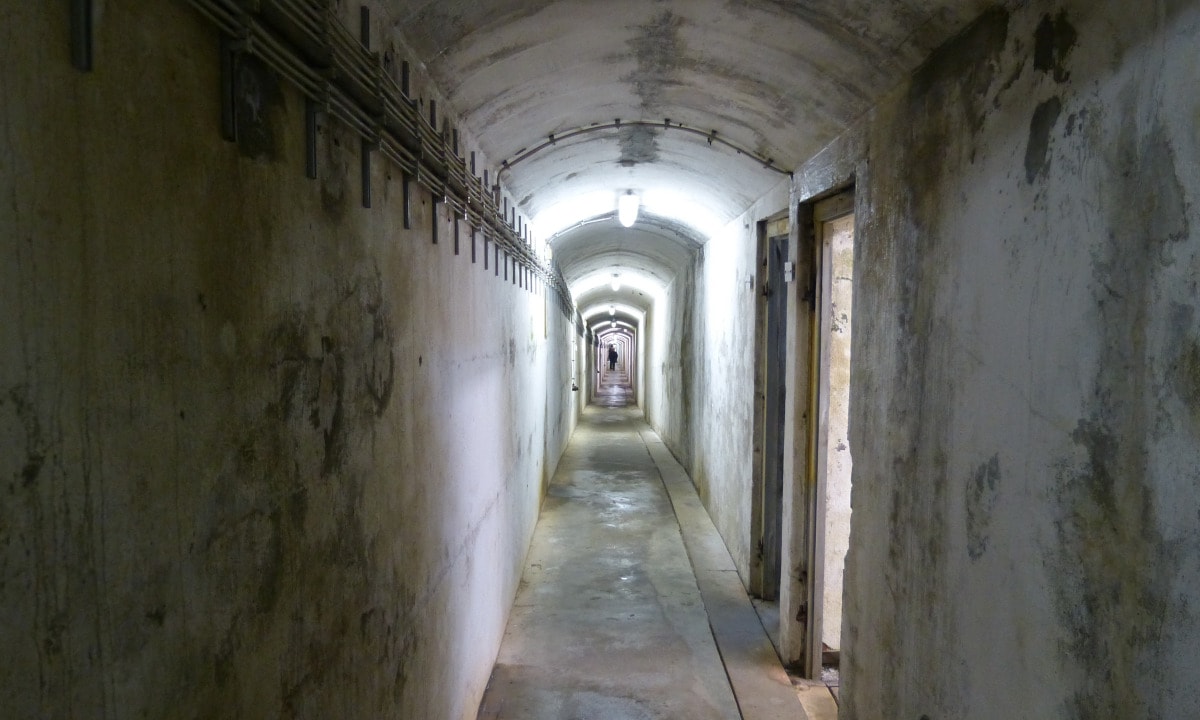
The Heligoland Bunker
Exactly two years after the first devastating bombing raid, on April 18, 1947, a British naval unit operated the remote detonator to carry out the largest single blast ever made by man, the "Big Bang."
But the project failed. The island and the village were devastated, but the rock held. Today's midland above the southern harbor was formed.
For another five years, Helgoland served the British Air Force as a bombing and torpedo drop site. All protests, requests and petitions for a termination bounced off the British government.
Only when two students, René Leudesdorff and Georg von Hatzfeld, raised the European flag on the island in a lone action on December 20, 1950, accompanied by reporters and journalists, did the British government stop the bombing.
On 01.03.1952 the release of Helgoland took place. The reconstruction was dangerous because of the unexploded bombs. In April 1954 the repatriation of the Helgoland families began.
A colorful Heligoland rose up as we know it today. Grassy bomb craters in the upper land remind us of the time of destruction. If we walk along the circular path, we find yellow-marked pyramids that give us an understanding of Helgoland's history. The bunker tours provide exciting insights into the underground tunnel system of the rocky island.
By the way, the visitor record with the incredible number of 831,387 guests was reached in 1971.


